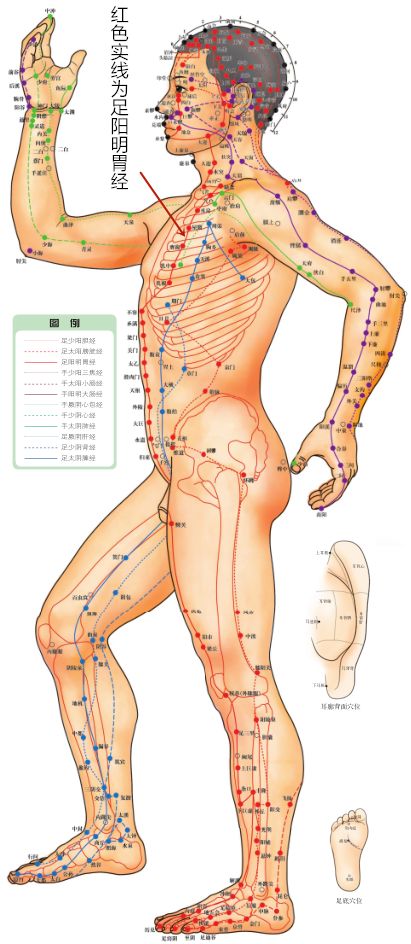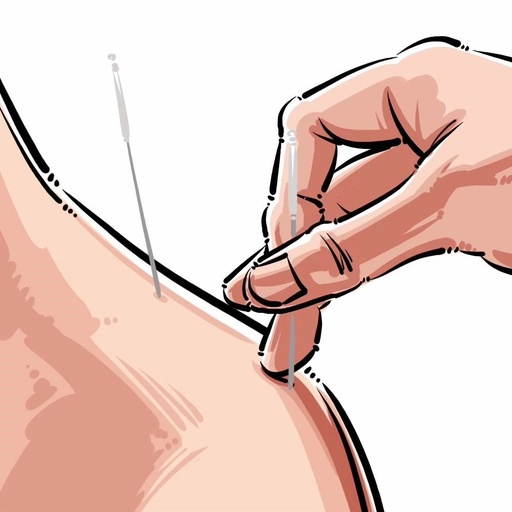Special Statement: Except for books, Dr. Luo Dalun has never recommended any products on Taobao. Any products labeled with “Luo Dalun” are unrelated to Dr. Luo Dalun. All products sold on Taobao under Dr. Luo’s name are unauthorized and infringe on his rights. Please be vigilant and avoid being deceived.
Warm Reminder
This section aims to introduce the basic knowledge of human acupoints, allowing everyone to have a fundamental understanding of them and a simple understanding of their application in external therapies such as moxibustion, cupping, and guasha. Many acupoints have high risks associated with needling; non-professionals should not attempt needling operations!
The Stomach Meridian of the Foot Yangming
🔹 Meridian Pathway
This meridian starts at the side of the nostril (Yingxiang point), ascends along the nose, intersects at the root of the nose, enters the inner canthus of the eye, intersects with the Foot Taiyang Meridian, descends along the outer side of the nasal column, enters the upper teeth, exits, runs alongside the mouth, encircles the lips, intersects at the Chengjiang point in the mentolabial groove, returns along the lower jaw bone to the Daying point, ascends along the angle of the jaw, passes in front of the ear, goes through the Shangguan point (Guest Master), along the hairline, and reaches the forehead.
A branch of this meridian descends from the Daying point to the Renying point, along the throat to the Dazhui, bends forward, enters the diaphragm, belongs to the stomach, and connects to the spleen. A straight branch descends from the Renying point, along the midline of the chest, runs alongside the navel (two inches lateral), and descends to the Qijie point outside the groin. Another branch emerges from the pylorus of the stomach, descends within the abdominal cavity to the Qijie point, meets with the straight branch, and then descends along the front of the thigh to the knee, along the anterior edge of the tibia to the dorsum of the foot, entering the lateral side of the second toe (Lidui point). Another branch emerges from the Zusanli point (3 cun below the knee) and descends to the lateral side of the middle toe. Yet another branch emerges from the Shangchong point on the dorsum of the foot, moving forward to the medial side of the big toe (Yinbai point), intersecting with the Foot Taiyin Spleen Meridian.

🔹 Summary of Indications
The acupoints of this meridian are indicated for intestinal rumbling, abdominal distension, abdominal pain, stomach pain, ascites, vomiting or excessive hunger, thirst, sore throat, epistaxis, pain in the chest and knee areas along the meridian, febrile diseases, and mania.
Acupoints of the Stomach Meridian of the Foot Yangming
🔹 Qi She
[Source] “The Classic of Acupuncture and Moxibustion”: “Goiter, Qi She is the main point. Shoulder swelling cannot be neglected, Qi She is the main point.”
[Location] In the region of the sternocleidomastoid muscle, in the supraclavicular fossa, at the upper edge of the sternal end of the clavicle, in the depression between the sternal head and the clavicular head of the sternocleidomastoid muscle.
[Needling Method] Can be taken in a sitting or supine position, located in the upper chest, directly below the Renying point, slightly medial to the root of the clavicle. Quick needling method: Turn the head to the side, locate the acupoint in the depression between the two muscles at the upper edge of the inner end of the clavicle.

[Indications]
-
Sore throat;
-
Goiter, scrofula;
-
Asthma, hiccups;
-
Stiff neck.
[Application]
Qi She. Qi refers to the material within the acupoint as the heavenly qi. She means source. The name Qi She indicates that this acupoint is an important source of qi for the Stomach Meridian. The material of this acupoint is the earthly qi transmitted from the Water Tuo point, located in the lower part of the neck. Due to its proximity to the area of the heart’s fire, its water and qi transformation is greater, thus generating more qi, making it an important source of qi for the Stomach Meridian, hence the name Qi She.
When experiencing persistent hiccups, acupressure on the Qi She point can be very effective in stopping hiccups. Qi She is indicated for sore throat, wheezing, coughing, asthma, pharyngitis, tonsillitis, laryngitis, asthma, whooping cough, bronchitis, hiccups, goiter, scrofula, stiff neck, neck stiffness, goiter, difficulty swallowing, thyroid enlargement, cervical lymphadenitis, diaphragm spasm, indigestion, difficulty swallowing, esophagitis, cervical lymphadenitis, stiff neck, cervical spondylosis, and cervical stiffness. Qi She is indicated for sore throat, wheezing, hiccups, goiter, scrofula, and stiff neck.
Qi She is primarily used to treat diseases of the chest, lungs, and neck, such as sore throat, goiter, scrofula, stiff neck, wheezing, difficulty swallowing, as well as thyroid enlargement, cervical lymphadenitis, pharyngitis, bronchitis, diaphragm spasm, and indigestion. Qi She is indicated for goiter, scrofula, stiff neck; sore throat; coughing, wheezing; hiccups, difficulty swallowing. Respiratory diseases: pharyngitis, tonsillitis, laryngitis, bronchitis, asthma, whooping cough. Digestive system diseases: esophagitis, diaphragm spasm, indigestion. Others: cervical lymphadenitis, thyroid enlargement, stiff neck, cervical spondylosis.
To stimulate the Qi She point, use the method of pressing with the fingertip. Place the pad of the index finger on the Qi She point, apply deep pressure for 10 seconds, then release, rest for 5 seconds, and press again. One press and release is one cycle. Press each side of the Qi She point for 1-3 minutes each time, twice daily.
This acupoint is not recommended for self-needling.
[Literature]
“The Classic of Acupuncture and Moxibustion”: Cheek swelling, mouth urgency, cheek pain, cannot chew.
“Classified Classic of Acupuncture”: Cheek pain, Dica, Water Ditch, Chengjiang, Tinghui, Hegu, main points for crooked mouth and eyes.
*Acupoint diagram from the book “Illustrated Huangdi Neijing” published by Zitu Publishing
Cover | Eight Years Old
Model | Yun Shao
Editor | Yuan Li

